Agroecology of Cyperus rotundus: Emergence Dynamics of as a Tool for Sustainable Weed Management
Abstract
1. Introduction
2. Materials and Methods
2.1. Plant Material
2.2. Laboratory Experiments
2.3. Outdoor Experiments
2.4. Tuber Viability After Sun Exposure
2.5. Statistical Analyses
3. Results
3.1. Laboratory Experiments
3.2. Emergence Experiments
3.3. Tuber Sprouting After Drying
4. Discussion
5. Conclusions
Funding
Institutional Review Board Statement
Informed Consent Statement
Data Availability Statement
Conflicts of Interest
References
- Peerzada, A.M. Biology, agricultural impact, and management of Cyperus rotundus L.: The world’s most tenacious weed. Acta Phys. Plant. 2017, 39, 270. [Google Scholar] [CrossRef]
- Bendixen, L.E.; Nandihalli, U.B. Worldwide distribution of purple and yellow nutsedge (Cyperus rotundus and C. esculentus). Weed Technol. 1987, 1, 61–65. [Google Scholar] [CrossRef]
- Zhang, H.Y.; Hanna, M.A.; Ali, Y.; Nan, L. Yellow nut-sedge (Cyperus esculentus L.) tuber oil as a fuel. Ind. Crops Prod. 1996, 5, 177–181. [Google Scholar] [CrossRef]
- Wills, G.D. Description of purple and yellow nutsedge (Cyperus rotundus and C. esculentus). Weed Technol. 1987, 1, 2–9. [Google Scholar] [CrossRef]
- Horowitz, M. Growth, tuber formation and spread of Cyperus rotundus L. from single tubers. Weed Res. 1972, 12, 348–363. [Google Scholar] [CrossRef]
- Williams, R.D. Growth and reproduction of Cyperus esculentus L. and Cyperus rotundus L. Weed Res. 1982, 22, 149–154. [Google Scholar] [CrossRef]
- Alsaadawi, I.S.; Salih, N.M.M. Allelopathic potential of Cyperus rotundus LI Interference with crops. Allelopath. J. 2009, 23, 297–304. [Google Scholar]
- Wang, C.; Hu, Y.; Wu, H.; Wang, Z.; Cai, J.; Liu, H.; Ren, W.; Yang, N.; Wang, Z.; Jiang, Y.; et al. No-tillage practice enhances soil total carbon content in a sandy Cyperus esculentus L. field. Ecol. Process. 2025, 14, 9. [Google Scholar] [CrossRef]
- Srivastava, R.; Singh, K.P. Diversity in weed seed production and the soil seed bank: Contrasting responses between two agroecosystems. Weed Biol. Manag. 2014, 14, 21–30. [Google Scholar] [CrossRef]
- Benvenuti, S.; Mazzoncini, M. “Active” weed seed bank: Soil texture and seed weight as key factors of burial-depth inhibition. Agronomy 2021, 11, 210. [Google Scholar] [CrossRef]
- Bryson, C.T.; Reddy, K.N.; Molin, W.T. Purple nutsedge (Cyperus rotundus) population dynamics in narrow row transgenic cotton (Gossypium hirsutum) and soybean (Glycine max) rotation. Weed Technol. 2003, 17, 805–810. [Google Scholar] [CrossRef]
- Benvenuti, S.; Pardossi, A. Weed seedbank dynamics in Mediterranean organic horticulture. Sci. Hortic. 2017, 221, 53–61. [Google Scholar] [CrossRef]
- Pena-Fronteras, J.T.; Villalobos, M.C.; Baltazar, A.M.; Merca, F.E.; Ismail, A.M.; Johnson, D.E. Adaptation to flooding in upland and lowland ecotypes of Cyperus rotundus, a troublesome sedge weed of rice: Tuber morphology and carbohydrate metabolism. Ann. Bot. 2009, 103, 295–302. [Google Scholar] [CrossRef]
- Yi, S.C.; Wei, C.Y.; Tong, Y.; Xu, L.; Fan, D.L.; Yu, S.X.; Liu, S.Y.; Wu, R.H.; Liu, X.L.; Tang, W.W. Mature tubers of purple nutsedge (Cyperus rotundus) confer flooding tolerance by adopting a low-oxygen quiescence strategy that may contribute to its emergence in rice fields. Weed Sci. 2024, 72, 761–773. [Google Scholar] [CrossRef]
- Kumar, M.; Das, T.K.; Yaduraju, N.T. An integrated approach for management of Cyperus rotundus (purple nutsedge) in soybean–wheat cropping system. Crop Prot. 2012, 33, 74–81. [Google Scholar] [CrossRef]
- Webster, T.M.; Grey, T.L. Halosulfuron reduced purple nutsedge (Cyperus rotundus) tuber production and viability. Weed Sci. 2014, 62, 637–646. [Google Scholar] [CrossRef]
- De Ryck, S.; Reheul, D.; De Cauwer, B. Impact of regular mowing, mowing height, and grass competition on tuber number and tuber size of yellow nutsedge clonal populations (Cyperus esculentus L.). Weed Res. 2023, 63, 371–381. [Google Scholar] [CrossRef]
- Bangarwa, S.K.; Norsworthy, J.K.; Jha, P.; Malik, M. Purple nutsedge (Cyperus rotundus) management in an organic production system. Weed Sci. 2008, 56, 606–613. [Google Scholar] [CrossRef]
- Warren, L.S., Jr.; Coble, H.D. Managing purple nutsedge (Cyperus rotundus) populations utilizing herbicide strategies and crop rotation sequences. Weed Technol. 1999, 13, 494–503. [Google Scholar] [CrossRef]
- Phatak, S.C.; Callaway, M.B.; Vavrina, C.S. Biological control and its integration in weed management systems for purple and yellow nutsedge (Cyperus rotundus and C. esculentus). Weed Technol. 1997, 1, 84–91. [Google Scholar] [CrossRef]
- Kadir, J.B.; Charudattan, R.; Stall, W.M.; Brecke, B.J. Field efficacy of Dactylaria higginsii as a bioherbicide for the control of purple nutsedge (Cyperus rotundus). Weed Technol. 2000, 14, 1–6. [Google Scholar] [CrossRef]
- Webster, T.M. Mulch type affects growth and tuber production of yellow nutsedge (Cyperus esculentus) and purple nutsedge (Cyperus rotundus). Weed Sci. 2005, 53, 834–838. [Google Scholar] [CrossRef]
- Nath, C.P.; Kumar, N.; Dutta, A.; Hazra, K.K.; Praharaj, C.S.; Kumar, D.; Dixit, G.P. Cover crop and herbicides can control purple nutsedge (Cyperus rotundus L.) and increase crop yields in conservation agriculture-based crop rotations. Crop Prot. 2025, 187, 106974. [Google Scholar] [CrossRef]
- Lamour, A.; Lotz, L.A. The importance of tillage depth in relation to seedling emergence in stale seedbeds. Ecol. Model. 2007, 201, 536–546. [Google Scholar] [CrossRef]
- Riemens, M.M.; Van der Weide, R.Y.; Runia, W.T. Biology and Control of Cyperus rotundus and Cyperus esculentus, Review of a Literature Survey; Plant Research International: Wageningen, The Netherlands, 2008. [Google Scholar]
- Steel, R.G.; Torrie, D. Principles and Procedures of Statistics: A Biometrical Approach, 2nd ed.; McGraw-Hill Inc.: Columbus, OH, USA, 1980. [Google Scholar]
- Singh, S.; Singh, M. Effect of temperature, light and pH on germination of twelve weed species. Indian J. Weed Sci. 2009, 41, 113–126. [Google Scholar]
- Penfield, S. Seed dormancy and germination. Curr. Biol. 2017, 27, R874–R878. [Google Scholar] [CrossRef]
- Zivanai, M.; Ronald, M.; Nester, M. The role of tillage, allelopathy, dormancy-breaking mechanisms and wind in the spread of purple nutsedge (Cyperus rotundus) in Zimbabwe. Agric. Res. 2019, 8, 461–466. [Google Scholar] [CrossRef]
- Leck, M.A.; Schütz, W. Regeneration of Cyperaceae, with particular reference to seed ecology and seed banks. Perspect. Plant Ecol. Evol. Syst. 2005, 7, 95–133. [Google Scholar] [CrossRef]
- Rosbakh, S.; Hülsmann, L.; Weinberger, I.; Bleicher, M.; Poschlod, P. Bleaching and cold stratification can break dormancy and improve seed germination in Cyperaceae. Aquat. Bot. 2019, 158, 103128. [Google Scholar] [CrossRef]
- Casal, J.J.; Sánchez, R.A. Phytochromes and seed germination. Seed Sci. Res. 1998, 8, 317–329. [Google Scholar] [CrossRef]
- Benvenuti, S. Soil light penetration and dormancy of jimsonweed (Datura stramonium) seeds. Weed Sci. 1995, 43, 389–393. [Google Scholar] [CrossRef]
- Milberg, P.; Andersson, L.; Thompson, K. Large-seeded spices are less dependent on light for germination than small-seeded ones. Seed Sci. Res. 2000, 10, 99–104. [Google Scholar] [CrossRef]
- Neeser, C.; Aguero, R.; Swanton, C.J. Survival and dormancy of purple nutsedge (Cyperus rotundus) tubers. Weed Sci. 1997, 45, 784–790. [Google Scholar] [CrossRef]
- Du, L.; Gao, X.; Qu, C.; Bai, S.; Shi, C.; Jiang, X.; Li, X.; Ju, Q.; Qu, M. Identification of purple nutsedge (Cyperus rotundus L.) ecotypes and the effect of environmental factors on tuber sprouting in China. Weed Res. 2022, 62, 360–371. [Google Scholar] [CrossRef]
- Kawabata, O.; Nishimoto, R.K. Temperature and rhizome chain effect on sprouting of purple nutsedge (Cyperus rotundus) ecotypes. Weed Sci. 2003, 51, 348–355. [Google Scholar] [CrossRef]
- Taylorson, R.B. Seasonal variation in sprouting and available carbohydrate in yellow nutsedge tubers. Weeds 1967, 15, 22–24. [Google Scholar] [CrossRef]
- Dor, E.; Hershenhorn, J. Effect of low temperature on purple nutsedge (Cyperus rotundus) reproductive biology. Weed Sci. 2013, 61, 239–243. [Google Scholar] [CrossRef]
- Mijani, S.; Rastgoo, M.; Ghanbari, A.; Nassiri Mahallati, M.; González-Andújar, J.L. Development of a new thermal time model for describing tuber sprouting of Purple nutsedge (Cyperus rotundus L.). Weed Res. 2021, 61, 431–442. [Google Scholar] [CrossRef]
- Benvenuti, S. Soil texture involvement in germination and emergence of buried weed seeds. Agron. J. 2003, 95, 191–198. [Google Scholar] [CrossRef]
- Benvenuti, S.; Macchia, M.; Miele, S. Quantitative analysis of emergence of seedlings from buried weed seeds with increasing soil depth. Weed Sci. 2001, 49, 528–535. [Google Scholar] [CrossRef]
- Benvenuti, S.; Mazzoncini, M. Soil physics involvement in the germination ecology of buried weed seeds. Plants 2018, 8, 7. [Google Scholar] [CrossRef]
- Bezuidenhout, S.R.; Reinhardt, C.F.; Whitwell, M.I. Cover crops of oats, stooling rye and three annual ryegrass cultivars influence maize and Cyperus esculentus growth. Weed Res. 2012, 52, 153–160. [Google Scholar] [CrossRef]
- Wauters, V.M.; Grossman, J.M.; Pfeiffer, A.; Cala, R. Ecosystem services and cash crop tradeoffs of summer cover crops in northern region organic vegetable rotations. Front. Sustain. Food Syst. 2021, 5, 635955. [Google Scholar] [CrossRef]
- Bangarwa, S.K.; Norsworthy, J.K.; Gbur, E.E. Effects of shoot clipping–soil disturbance frequency and tuber size on aboveground and belowground growth of purple and yellow nutsedge (Cyperus rotundus and Cyperus esculentus). Weed Technol. 2012, 26, 813–817. [Google Scholar] [CrossRef]
- Chadha, A.; Florentine, S.K.; Dhileepan, K.; Turville, C. Effect of rhizome fragment length and burial depth on the emergence of a tropical invasive weed Cyperus aromaticus (Navua Sedge). Plants 2022, 11, 3331. [Google Scholar] [CrossRef]
- Niemeyer, P.W.; Irisarri, I.; Scholz, P.; Schmitt, K.; Valerius, O.; Braus, G.H.; Herrfurth, C.; Feussner, I.; Sharma, S.; Carlsson, A.S.; et al. A seed-like proteome in oil-rich tubers. Plant J. 2022, 112, 518–534. [Google Scholar] [CrossRef] [PubMed]
- Tripathi, R.S. Ecology of Cyperus rotundus L.-3. Population of tubers at different depths of the soil and their sprouting response to air drying. Proc. Nat. Acad. Sci. India 1969, 39, 140–142. [Google Scholar]
- Henry, G.M.; Elmore, M.T.; Gannon, T.W. Cyperus esculentus and Cyperus rotundus. In Biology and Management of Problematic Crop Weed Species; Academic Press: Cambridge, MA, USA, 2021; pp. 151–172. [Google Scholar]
- Follak, S.; Belz, R.; Bohren, C.; De Castro, O.; Del Guacchio, E.; Pascual-Seva, N.; Schwarz, M.; Verloove, F.; Essl, F. Biological flora of central Europe: Cyperus esculentus L. Perspect. Plant Ecol. Evol. Syst. 2016, 23, 33–51. [Google Scholar] [CrossRef]
- Benvenuti, S. Ecology of Cyperus Rotundus Seedling Emergence and Agronomic Strategies for Sustainable Management. Available online: https://ssrn.com/abstract=5396449 (accessed on 15 September 2025).
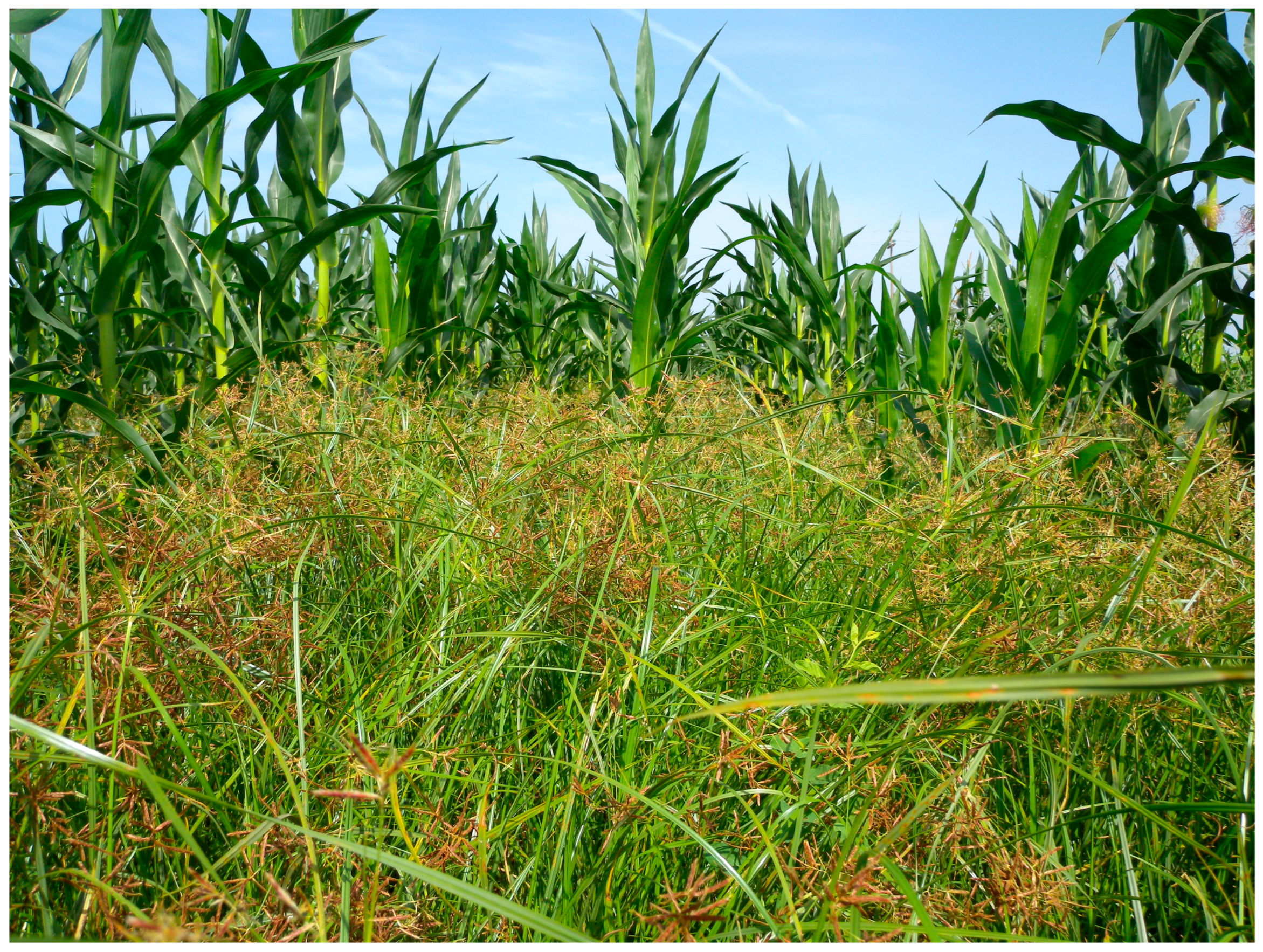
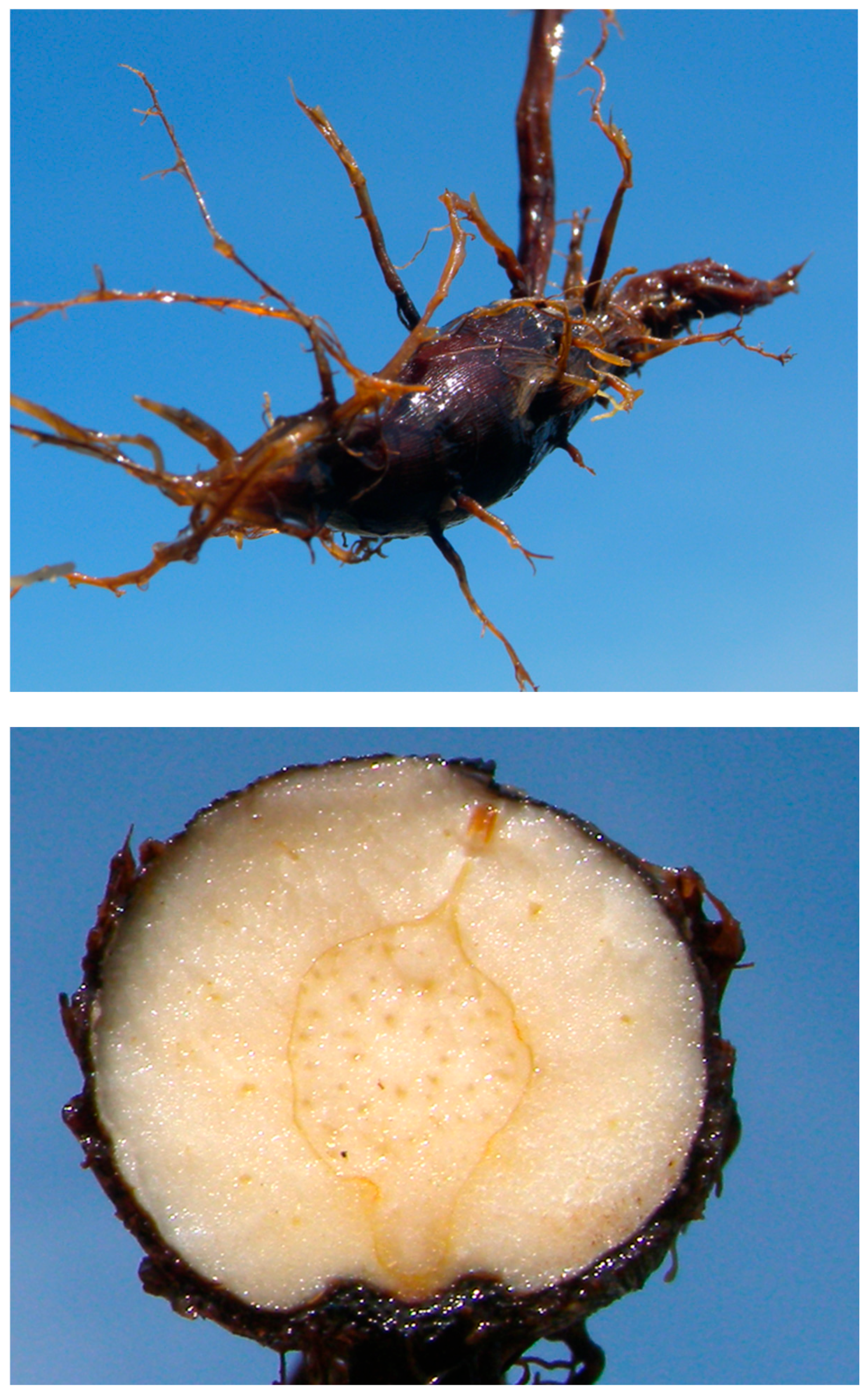
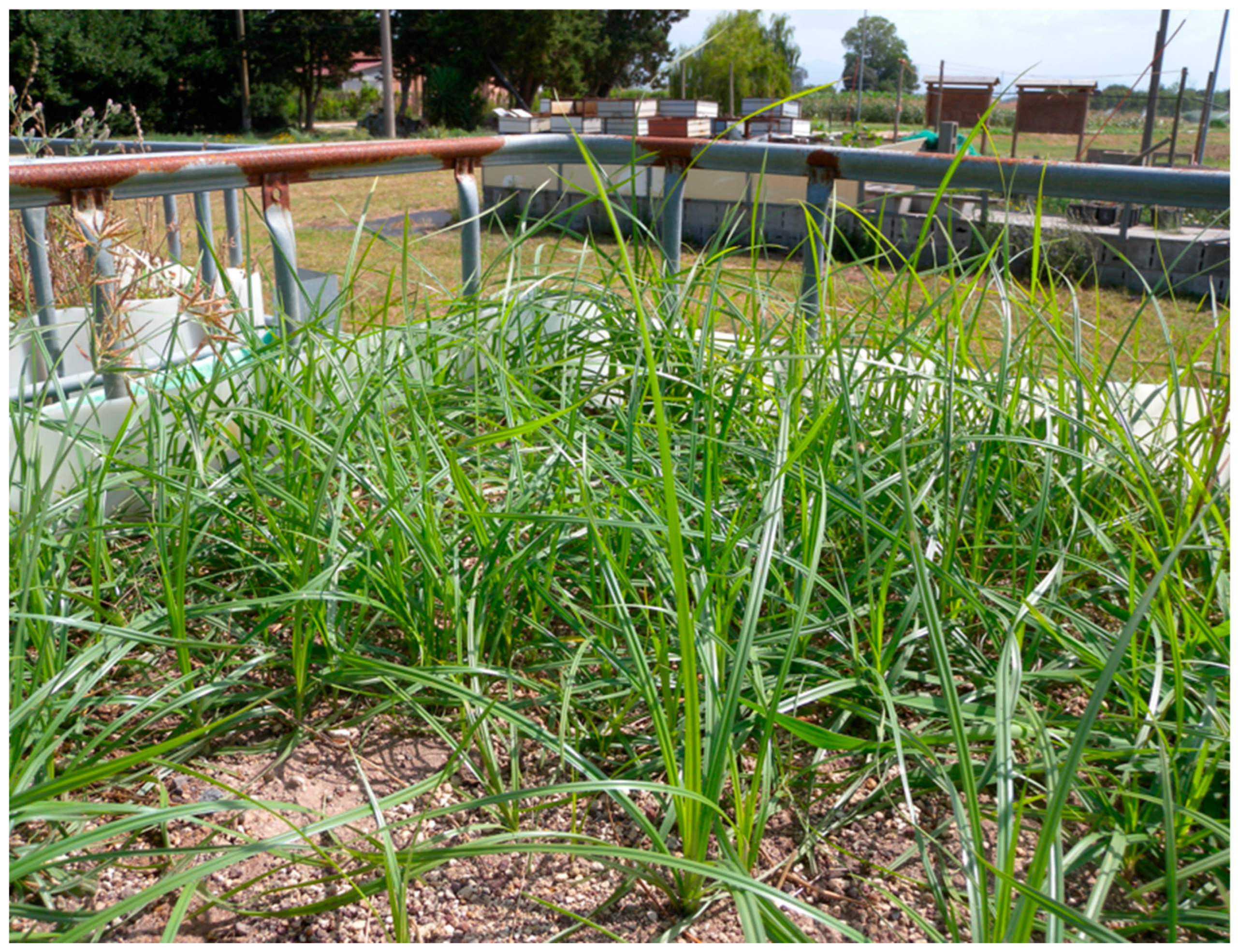
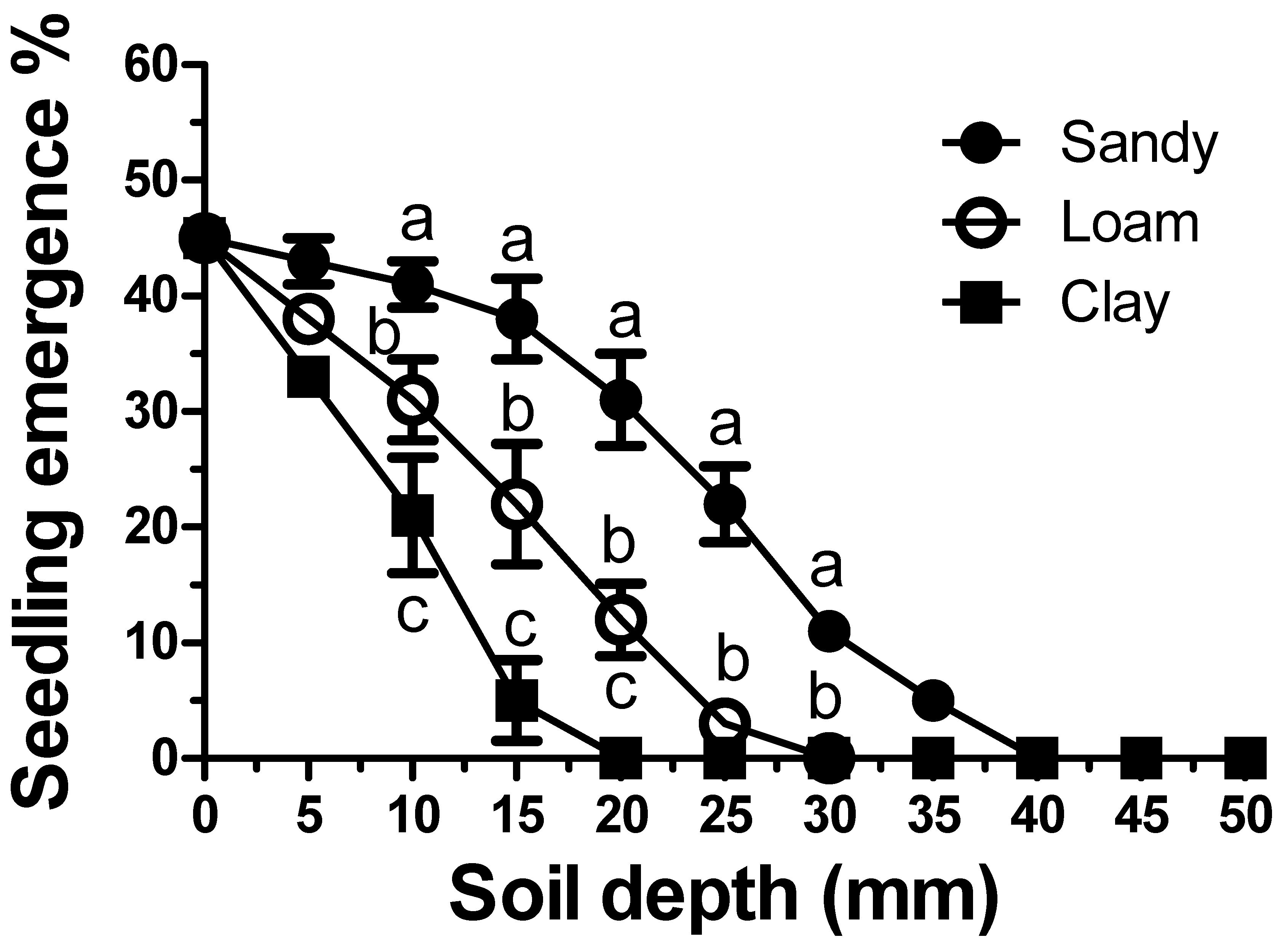
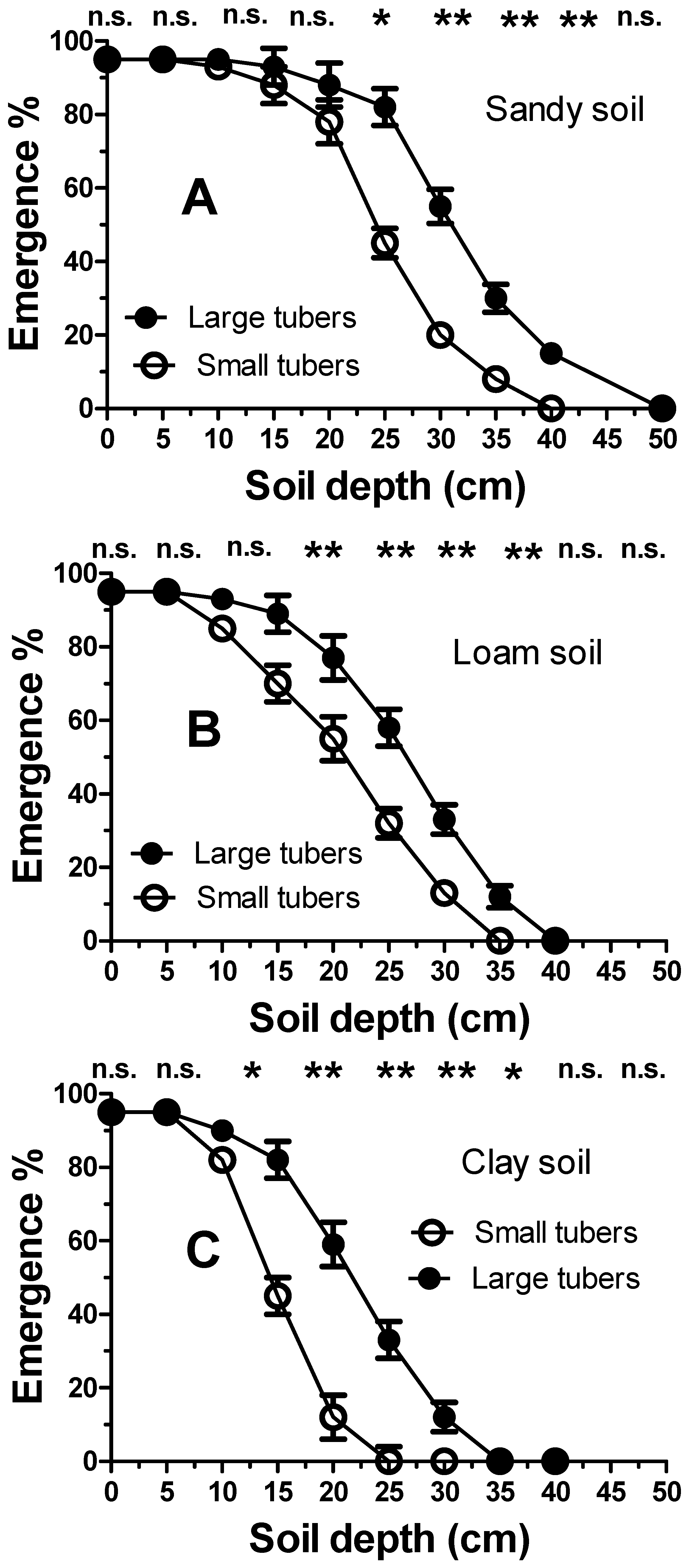
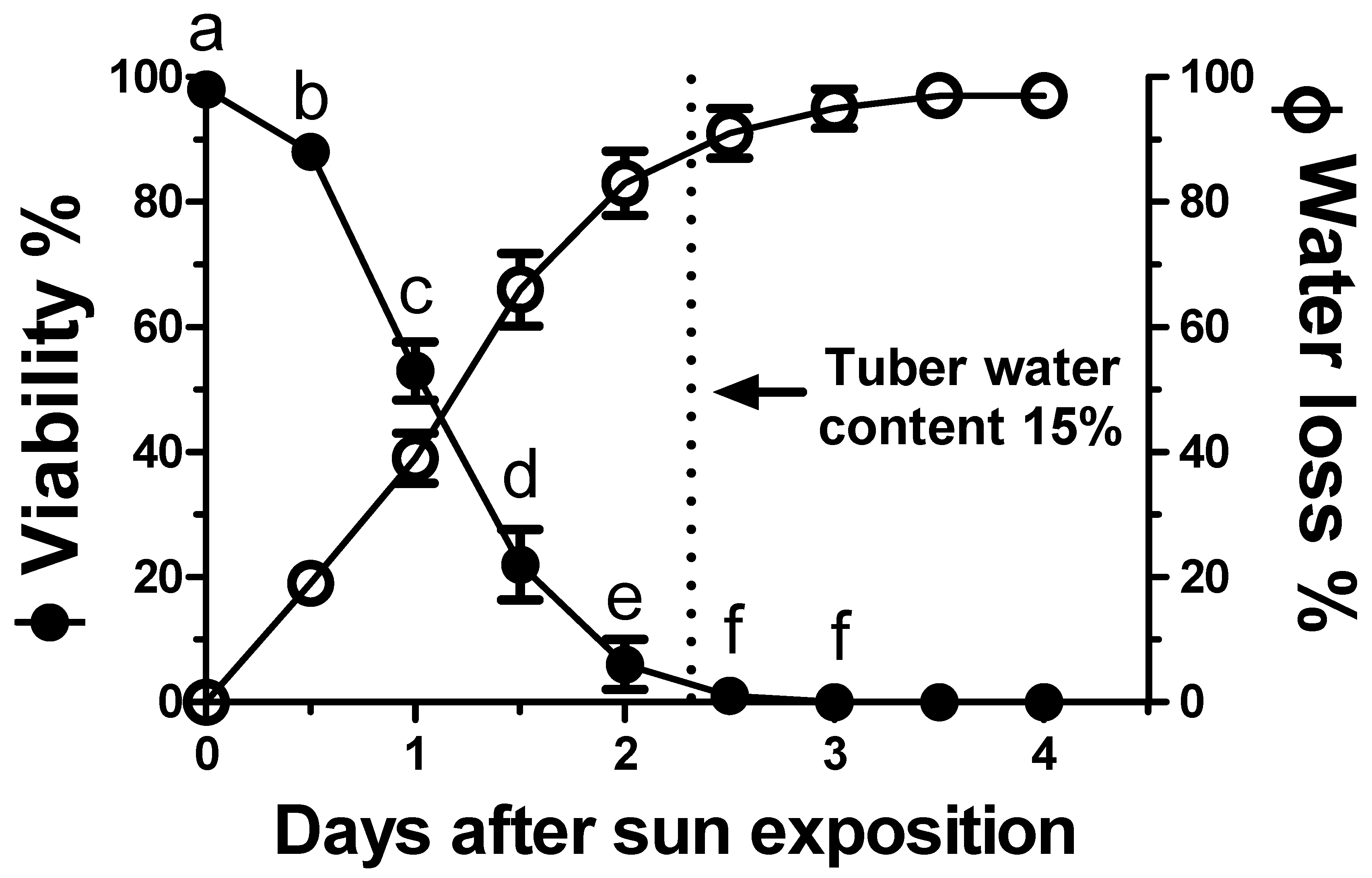
| Plant Organ | Incubation Environment | Temperature (°C) | Light Effect Significance | ||
|---|---|---|---|---|---|
| Germination/Sprouting % | |||||
| 20 | 30 | 40 | |||
| Seed | Light | 23.0 ± 3.2 a | 43.0 ± 2.8 b | 45.2 ± 3.2 b | ** |
| Dark | 11.0 ± 2.9 a | 23.6 ± 2.2 b | 27.3 ± 2.8 b | ||
| Tuber | Light | 75.1 ± 0.6 a | 88.0 ± 0.2 b | 89.2 ± 0.1 b | n.s. |
| Dark | 74.8 ± 0.5 a | 87.0 ± 0.3 b | 88.9 ± 0.2 b | ||
Disclaimer/Publisher’s Note: The statements, opinions and data contained in all publications are solely those of the individual author(s) and contributor(s) and not of MDPI and/or the editor(s). MDPI and/or the editor(s) disclaim responsibility for any injury to people or property resulting from any ideas, methods, instructions or products referred to in the content. |
© 2025 by the author. Licensee MDPI, Basel, Switzerland. This article is an open access article distributed under the terms and conditions of the Creative Commons Attribution (CC BY) license (https://creativecommons.org/licenses/by/4.0/).
Share and Cite
Benvenuti, S. Agroecology of Cyperus rotundus: Emergence Dynamics of as a Tool for Sustainable Weed Management. Sustainability 2025, 17, 9543. https://doi.org/10.3390/su17219543
Benvenuti S. Agroecology of Cyperus rotundus: Emergence Dynamics of as a Tool for Sustainable Weed Management. Sustainability. 2025; 17(21):9543. https://doi.org/10.3390/su17219543
Chicago/Turabian StyleBenvenuti, Stefano. 2025. "Agroecology of Cyperus rotundus: Emergence Dynamics of as a Tool for Sustainable Weed Management" Sustainability 17, no. 21: 9543. https://doi.org/10.3390/su17219543
APA StyleBenvenuti, S. (2025). Agroecology of Cyperus rotundus: Emergence Dynamics of as a Tool for Sustainable Weed Management. Sustainability, 17(21), 9543. https://doi.org/10.3390/su17219543






